Hiking the Alps, learning history, visiting villages and seeing castles are among some of the exciting activities German students participated in during a 10-day European trip over the summer.
From July 22 to July 31, the students visited Germany, Austria, Switzerland, and Lichtenstein as part of an educational trip. During the trip, students learned about topics including architecture, culture, and history. Throughout the trip, the group had a tour manager who provided history and information about all of the areas.
“He knew a lot beforehand about the culture, he showed us a lot of things that even some of the city guides didn’t know,” senior Ashlynn Eshberger said. “It was nice to walk around the city and know things that other tourists aren’t going to know. He made it a lot more fun because he’s hilarious, we love him.”
The first city the group visited was Vienna, Austria where they stayed for two days.
“I think that was my favorite city, we saw all the palaces all over Vienna, every street you looked down you could find a palace or a castle,” junior Keller Hannigan said. “It was very cool, very good architecture. We also went by the University of Vienna, which convinced me that it’s where I want to go to school, so that was inspiring.”
Unlike many American universities and colleges, tuition in German-speaking areas is quite low, even for international students, costing less than $1,000 per semester.
“Originally it was just seeing how amazing the University was while I was surrounded by the city, it looked like an amazing place,” Hannigan said. “I started doing research into it, just a little bit, and it’s looking cooler and cooler, it inspired me to go overseas and study in some German-speaking area.”
Later, the students visited another city in Austria, Salzburg.
“We learned a lot about the history of how the cities came to be,” senior Ian Miller said, “For example, we were in Salzburg in Austria and learned how the town developed with all of the salt around. They found salt in the mountains that became the main source of money that allowed the city to grow. We learned about Mozart and Ludwig II.”
The class traveled to south Germany, visiting Munich. While in Munich, the group discussed Nazi Germany and the crimes committed there and also visited varying historical sites including where book burnings occurred.
“In Bavaria, there were houses built by King Ludwig II back in the 1800s,” senior Ian Miller said. “He built fantasy castles that were pretty inaccurate to what history really would have been. It’s interesting how people were interested in the past even back then.”
After visiting Vienna and Munich, the group traveled to Lichtenstein and soon after visited Engelberg in Switzerland.
“We did a lot of city tours and learned a lot about the history of the places we went to, we also got to see several famous spots,” Eshberger said. “My favorite part was seeing Engelberg, which is a smaller town, just because of the culture and the area.”
While traveling, students noticed a difference in culture. Eshberger noticed it, especially in restaurant staff.
“The tipping culture is very different, the staff is different,” Eshberger said, ”They’re still very nice, but it’s kind of funny because they don’t put up with people’s bad behavior, so I thought that was great.“
Hannigan also remarked upon the language barrier and how you could distinctly hear many different dialects.
“Austria had a very strong accent, then in Bavaria, it gets even stronger and Switzerland it gets even worse,” Hannigan said. “We actually got very little standard German. In fact, in Switzerland, they’d prefer we speak in English because it’s too much effort for them to speak in standard German because they speak in such a crazy Swiss dialect.’”
Overall, the students enjoyed the sightseeing and learning throughout the multiple countries they visited.
“It was nice to see Germany and Austria first-hand because I got to experience the culture,” Eshburger said. “My favorite part was the free time in the cities that we got to have and just being able to experience the culture on your own.”










